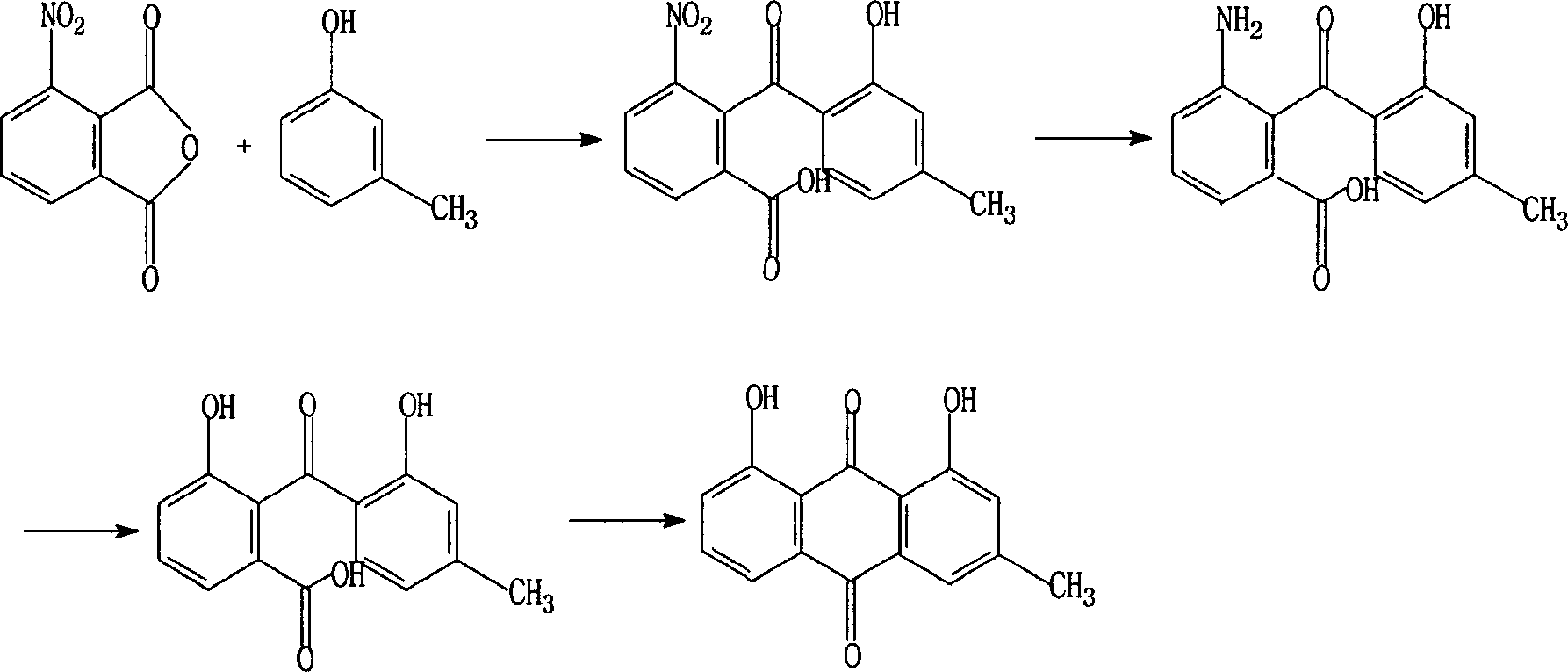Synthesis method of rhein and diacerein
A technology of diacerein and rhein, applied in chemical instruments and methods, carboxylate preparation, carboxylate preparation and other directions, can solve the problems of human harm, human and environmental pollution, high price of hydroiodic acid, etc. full response effect
- Summary
- Abstract
- Description
- Claims
- Application Information
AI Technical Summary
Problems solved by technology
Method used
Image
Examples
Embodiment 1
[0027] Embodiment 1, the preparation of 2-(2-hydroxyl-4-methylbenzoyl)-3-nitrobenzoic acid
[0028] Weigh 96.6g (0.5mol) of 3-nitrophthalic anhydride and 400g (3.7mol) of m-cresol, and put them into a 2L three-necked flask equipped with a sealed stirrer, anhydrous calcium chloride drying tube and reflux condenser In the process, the flask was cooled in an ice-water bath, and 200g (1.5mol) of powdered anhydrous aluminum trichloride was added at one time, started to stir, heated up, heated to 100-110°C, and stirred vigorously for 3 hours until the release of hydrogen chloride stopped. A thick reddish-brown substance was produced. Ice was added while stirring until the excess chromium trichloride passed through the addition of 150ml of concentrated hydrochloric acid, the product coagulated and the solution was clarified. After filtration, the filter cake was treated with 50 g of sodium carbonate, filtered, and dried to obtain 107.8 g of white crystal 2-(2-hydroxy-4-methylbenzoyl...
Embodiment 2
[0029] Embodiment two, the preparation of 2-(2-hydroxyl-4-methylbenzoyl)-3-aminobenzoic acid
[0030] 301 g (1 mol) of 2-(2-hydroxy-4-methylbenzoyl)-3-nitrobenzoic acid, 300 ml of absolute ethanol and 5 g of Raney nickel were put into a 1 L autoclave. Close the autoclave, feed hydrogen, raise the temperature to 25°C to make the pressure 20-40Mpa, stir at a medium speed, rapidly raise the temperature to 90°C, stop heating, and maintain the reaction at 90-100°C for 8 hours. Cool, depressurize, and filter the catalyst. Ethanol was distilled off, and the residue was recrystallized to obtain 255 g of the amino compound, with a yield of 94.1%, mp: 225-226° C., and content (HPLC) ≥ 96.5%.
Embodiment 3
[0031] Embodiment three, the preparation of 2-(2-hydroxyl-4-methylbenzoyl)-3-hydroxybenzoic acid
[0032] Put 27.1g (0.1mol) of 2-(2-hydroxy-4-methylbenzoyl)-3-aminobenzoic acid into a 500ml three-necked flask, add 50ml of water, then slowly add 15ml of concentrated sulfuric acid, and the reaction solution will spontaneously After heating up, cool to 0-5°C. Slowly add 35g of 20% sodium nitrite solution dropwise to the flask, keep the temperature not exceeding 5°C, after the addition, stir and react for 0.5 hours, then add 3g of urea, heat to boiling, cool slightly, add 1g of activated carbon, decolorize and filter, cool to After recrystallization at 0°C, 23.6g of dry product was obtained, yield 76.2%, mp: 240-241°C, content (HPLC) ≥ 97.0%.
PUM
 Login to View More
Login to View More Abstract
Description
Claims
Application Information
 Login to View More
Login to View More - R&D
- Intellectual Property
- Life Sciences
- Materials
- Tech Scout
- Unparalleled Data Quality
- Higher Quality Content
- 60% Fewer Hallucinations
Browse by: Latest US Patents, China's latest patents, Technical Efficacy Thesaurus, Application Domain, Technology Topic, Popular Technical Reports.
© 2025 PatSnap. All rights reserved.Legal|Privacy policy|Modern Slavery Act Transparency Statement|Sitemap|About US| Contact US: help@patsnap.com


